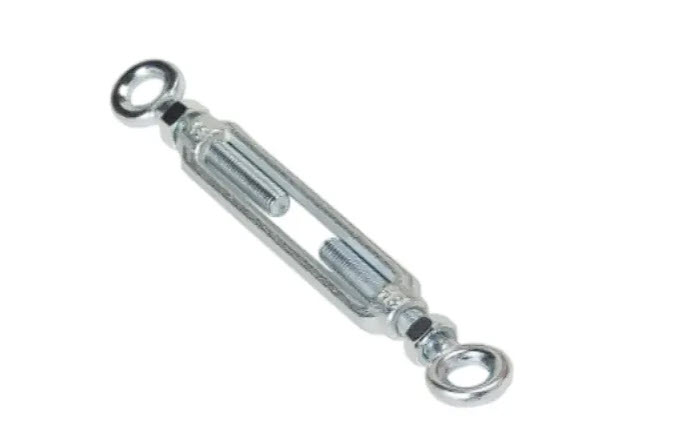Turnbuckle: A Device Used to Adjust the Tension of the Standing Rigging, Helping to Secure the Mast
Definition:
A turnbuckle is a mechanical device used to adjust the tension in the standing rigging on a sailboat. It consists of two threaded eyelets or end fittings connected by a metal body that can be rotated to either increase or decrease the length of the turnbuckle, thereby tightening or loosening the rigging. Turnbuckles are essential for ensuring that the mast is properly secured and that the rigging is tensioned correctly.
Understanding the Turnbuckle:
Turnbuckles play a critical role in the setup and maintenance of a sailboat's rigging. The standing rigging, which includes shrouds and stays, provides the necessary support to keep the mast upright and stable. By adjusting the turnbuckles, sailors can fine-tune the tension of these rigging lines, ensuring that the mast is straight and properly aligned. Correct tensioning is vital for the boat’s performance and safety, as improperly tensioned rigging can lead to mast instability or failure.
Components of a Turnbuckle:
End Fittings:
These are the threaded components at each end of the turnbuckle. Common types of end fittings include eye bolts, jaw fittings, and toggles. These are attached to the rigging lines and the deck fittings or chainplates.
Body:
The central part of the turnbuckle, which connects the two end fittings. The body is typically a hollow, threaded cylinder that can be rotated to adjust the tension. Turning the body one way tightens the rigging, while turning it the other way loosens it.
Locking Mechanism:
Some turnbuckles include a locking mechanism, such as lock nuts or safety wire, to prevent the turnbuckle from loosening unintentionally due to vibrations or movement.
How a Turnbuckle Works:
Tightening the Rigging:
To increase the tension in a rigging line, the turnbuckle body is rotated so that the threaded ends move closer together, effectively shortening the length of the turnbuckle and pulling the rigging line tighter.
Loosening the Rigging:
To decrease the tension, the turnbuckle body is rotated in the opposite direction, lengthening the turnbuckle and loosening the rigging line.
Adjustment Process:
The adjustment of turnbuckles is typically done when the mast is being stepped or during regular maintenance. It is important to adjust each turnbuckle carefully to ensure even tension across all rigging lines, which helps maintain the mast's alignment and stability.
Applications in Sailing:
Rigging Tension:
Turnbuckles are used to adjust the tension of the standing rigging, including shrouds (which provide lateral support) and stays (which provide fore-and-aft support). Proper tensioning is crucial for maintaining mast integrity and optimizing sail performance.
Mast Setup:
When stepping the mast, turnbuckles are adjusted to ensure that the mast is straight and properly supported. This adjustment helps distribute the loads evenly across the rigging.
Regular Maintenance:
Turnbuckles require periodic inspection and adjustment to account for changes in rigging tension due to stretch, wear, or environmental factors.
Examples of Usage:
"After stepping the mast, we tightened the turnbuckles to ensure the rigging was properly tensioned."
"Regularly inspect the turnbuckles for signs of corrosion or wear and check that they are securely locked."
"Adjusting the turnbuckles is essential for fine-tuning the rigging and maintaining the mast's alignment."
Visual Representation:
Image Description:
Diagram of a turnbuckle showing its components, including the body and end fittings, and illustrating how it adjusts the tension of the standing rigging.
Importance in Sailing:
Turnbuckles are vital components in the rigging system of a sailboat. They allow sailors to precisely adjust the tension of the standing rigging, which is crucial for maintaining the mast's stability and ensuring the boat's performance and safety. Proper use and maintenance of turnbuckles are essential for preventing rigging failures and optimizing sailing conditions.
Related Terms:
Standing Rigging:
The fixed rigging on a sailboat, including shrouds and stays, which provides support to the mast.
Shrouds:
Wires or rods that run from the mast to the sides of the boat, providing lateral support.
Stays:
Wires or rods that run from the mast to the bow (forestay) and stern (backstay) of the boat, providing fore-and-aft support.
Chainplate:
A metal fitting on the deck or hull to which the standing rigging is attached.
Conclusion:
The turnbuckle is a crucial device used to adjust the tension of the standing rigging on a sailboat, ensuring that the mast is securely supported and properly aligned. By allowing precise control over rigging tension, turnbuckles help maintain the stability and performance of the boat. Regular inspection and adjustment of turnbuckles are essential for safe and effective sailing.

